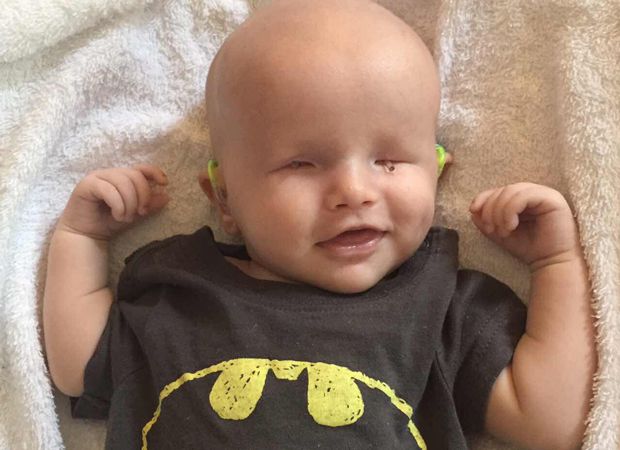Baby Born Without Eyes: A Comprehensive Guide To Bilateral Anophthalmia

Table of Contents
Causes of Bilateral Anophthalmia
Bilateral anophthalmia's etiology is complex, often involving a combination of genetic and environmental factors. While pinpointing the exact cause remains challenging in many cases, research continues to shed light on potential contributing elements.
Genetic Factors
Gene mutations play a significant role in many cases of bilateral anophthalmia. Inherited conditions can increase the risk, with several genes identified as potentially linked to the condition. These genetic variations can disrupt the complex developmental processes involved in eye formation during pregnancy.
- Key Genes: While research is ongoing, several genes, including PAX6, SOX2, and OTX2, have been implicated in anophthalmia and related eye conditions.
- Associated Syndromes: Bilateral anophthalmia can be associated with various genetic syndromes, such as anophthalmia-microphthalmia syndrome, which often presents with additional developmental abnormalities. Other syndromes linked to anophthalmia include CHARGE syndrome and Rieger syndrome.
Environmental Factors
Environmental factors during pregnancy can also contribute to bilateral anophthalmia, though their precise roles are often difficult to determine.
- Potential Risk Factors: Exposure to certain medications, infections (like rubella), or teratogens during critical periods of fetal development might increase the risk. Maternal health issues during pregnancy could also play a role.
- Uncertainties: In a significant number of cases, the precise cause of bilateral anophthalmia remains unknown, highlighting the need for ongoing research into the complex interplay of genetic and environmental influences.
Diagnosis and Prenatal Detection
Early diagnosis of bilateral anophthalmia is crucial for effective management and support. This can occur both before and after birth.
Prenatal Diagnosis
Prenatal detection of bilateral anophthalmia is possible, albeit not always definitive, through advanced imaging techniques.
- Ultrasound: Ultrasound scans during pregnancy can sometimes reveal the absence of developing eyes. However, the accuracy varies depending on the gestational age and the quality of the scan.
- Other Imaging Techniques: While less common for routine prenatal screening, other imaging modalities, like MRI, may be used in specific cases to confirm the diagnosis prenatally.
- Limitations: Prenatal diagnosis of bilateral anophthalmia is not always accurate, and further assessment is typically necessary after birth to confirm the diagnosis and rule out other related conditions.
Postnatal Diagnosis
Postnatal diagnosis involves a thorough physical examination by an ophthalmologist or other medical professionals immediately after birth.
- Physical Examination: A simple visual inspection will confirm the absence of eyes.
- Further Tests: Further tests may be conducted to assess for related conditions and to rule out other potential causes of eye absence. These might include genetic testing and other imaging studies.
Treatment Options and Management for Bilateral Anophthalmia
While bilateral anophthalmia is not curable, various treatment options and management strategies can significantly improve quality of life.
Prosthetic Eyes (Ocular Prostheses)
Prosthetic eyes provide cosmetic improvement and can help with facial symmetry. Different types of prostheses are available, from simple shells to more complex, custom-made devices.
Sensory Integration Therapy
Sensory integration therapy focuses on improving the child's ability to process sensory information and can be particularly helpful in addressing sensory challenges often associated with bilateral anophthalmia.
Early Intervention
Early intervention programs are crucial for maximizing a child's developmental potential. These programs often involve specialized education, therapies, and support services tailored to the child's unique needs.
Support Groups and Resources
Connecting with support groups and organizations provides invaluable emotional and practical support for families affected by bilateral anophthalmia. These networks offer a platform for sharing experiences, accessing resources, and finding community. [Link to relevant support organization 1] [Link to relevant support organization 2]
Living with Bilateral Anophthalmia: Daily Life and Challenges
Living with bilateral anophthalmia presents unique challenges, but with the right support and strategies, individuals can lead fulfilling lives.
Mobility and Independence
Navigating daily life requires developing adaptive strategies, including the use of mobility aids, assistive technology, and orientation and mobility training.
Social and Emotional Well-being
The emotional impact on the child and family is significant. Building strong support systems, providing emotional support, and fostering a positive self-image are crucial.
Educational Considerations
Specialized educational programs and support are necessary to address the unique learning needs of children with bilateral anophthalmia.
Conclusion:
Bilateral anophthalmia is a complex condition requiring comprehensive understanding and support. Early diagnosis, appropriate treatment options, including prosthetic eyes and early intervention programs, coupled with access to supportive resources and networks, are essential for optimal management. Remember that understanding bilateral anophthalmia and seeking professional guidance is crucial for families affected by this condition. Learn more about bilateral anophthalmia and find support for bilateral anophthalmia by connecting with the resources mentioned above. Understanding bilateral anophthalmia is key to empowering families and fostering a positive future for children born with this condition.

Featured Posts
-
 Celtics Clinch Division Title With Dominant Victory
May 11, 2025
Celtics Clinch Division Title With Dominant Victory
May 11, 2025 -
 Valentina Shevchenkos Willingness For Zhang Weili Fight At Ufc 315
May 11, 2025
Valentina Shevchenkos Willingness For Zhang Weili Fight At Ufc 315
May 11, 2025 -
 Is City Name Michigan The Best College Town For You
May 11, 2025
Is City Name Michigan The Best College Town For You
May 11, 2025 -
 Trump Weighs New Restrictions On Migrant Detention Appeals
May 11, 2025
Trump Weighs New Restrictions On Migrant Detention Appeals
May 11, 2025 -
 Santorini Earthquake Decline Scientific Assessment And Uncertain Future Implications
May 11, 2025
Santorini Earthquake Decline Scientific Assessment And Uncertain Future Implications
May 11, 2025
